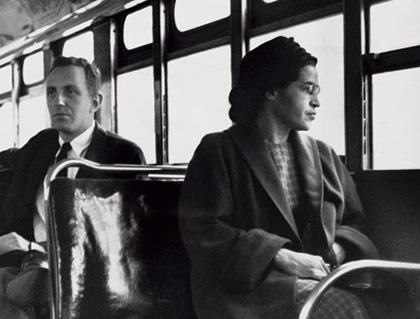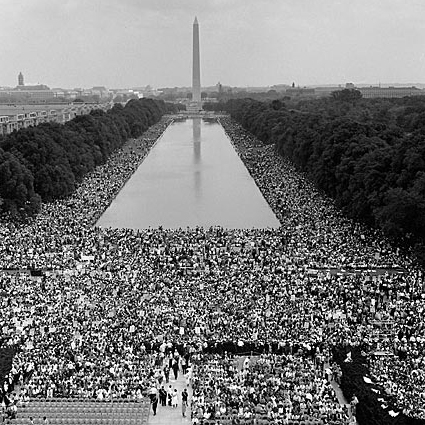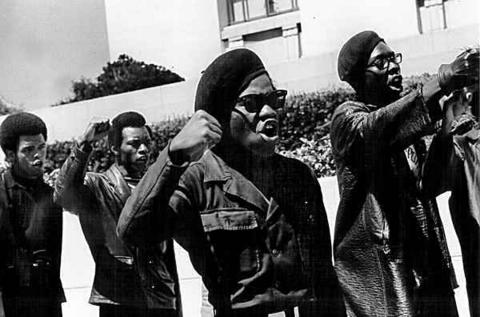

The Civil Rights Movement in America was a series of important events that combined to help African Americans receive their constitutional rights. The process was long and hard, but the results proved to be well worth the sacrifice. The main part of the movement took place in the 1950s and 1960s. These years saw both increased violence and racism. Protesters taking to the streets to work for their rights were often met with brutality, aggression and angry mobs. This time period also saw the death of many civil rights workers and the arrest of thousands more. Some tactics used during the movement were marches, protests, sit-ins, boycotts and legislation. The blending of these different tactics spread out over the years of the movement proved to be the best catalyst to change in America. Despite different methods of achieving rights, many blacks during the time period were adamantly demanding and working hard for their civil rights.
One of the first major events of the Civil Rights Movement was the landmark case, Brown v. Board of Education Topeka, Kansas. This case was decided by the Supreme Court in 1954 and had a large effect on segregation across the country. The long time idea of “separate but equal” was challenged. The problem in Kansas and many other areas around the country was that while blacks and whites were both receiving educational opportunities, the white schools were far superior to the black schools. They had better teachers, state funding, nicer facilities and more resources. As a result, black students were not being provided with their rights promised to every American in the Constitution. The inferior black schools did not give black students equal opportunities for success. The parents of elementary school kids in Topeka decided to sue to school district and desegregate schools so their kids could get an education equal to that of the white students. In a unanimous decision, the courts found it unconstitutional to segregate schooling based on race. White schools would now have to allow blacks students if they wished to attend. Despite this victory, the wording of the decision made the process more difficult. The judges said that schools should be desegregated, “with all deliberate speed” (US Supreme Court). This was left open to interpretation and would prove to limit and delay the process. Slowly but surely, some black students began to attend white schools, but it would be a long time before they were accepted as equals in the new integrated schools.
In the year following
the Supreme Court ruling, another important event took place. A black civil
rights activist and seamstress named Rosa Parks boarded a bus in Montgomery,
Alabama. Blacks were always forced to sit in the back of the bus but on December
1, 1955, Parks decided she was going to sit where she pleased. The bus driver
asked her to give her seat up to a wh ite
passenger and Parks refused to comply. She was consequently arrested and put on
trial. This action by the bus driver and the city of Montgomery enraged the
black community and caught the interest of famed civil rights leader Martin
Luther King Jr. The black citizens of Montgomery organized a bus boycott which
lasted around one year. Local churches were used as meeting area and staging
points to organize the boycott. Blacks did not ride the buses for this time
period and the bus company was crippled. This was one of the most successful
boycotts in American history. This greatly angered the white terrorist groups in
the south such as the Klu Klux Klan (KKK) and black churches and minister’s
homes were bombed. Snipers fired shots at blacks and other atrocities were
committed. In December of 1956, one year after the demonstration started, the
buses were desegregated and the boycott was over. (Blumberg 1984). Rosa Parks
had helped to start this large operation, but it was the cooperation of the
black community in Montgomery that made it a huge success.
ite
passenger and Parks refused to comply. She was consequently arrested and put on
trial. This action by the bus driver and the city of Montgomery enraged the
black community and caught the interest of famed civil rights leader Martin
Luther King Jr. The black citizens of Montgomery organized a bus boycott which
lasted around one year. Local churches were used as meeting area and staging
points to organize the boycott. Blacks did not ride the buses for this time
period and the bus company was crippled. This was one of the most successful
boycotts in American history. This greatly angered the white terrorist groups in
the south such as the Klu Klux Klan (KKK) and black churches and minister’s
homes were bombed. Snipers fired shots at blacks and other atrocities were
committed. In December of 1956, one year after the demonstration started, the
buses were desegregated and the boycott was over. (Blumberg 1984). Rosa Parks
had helped to start this large operation, but it was the cooperation of the
black community in Montgomery that made it a huge success.
For much of the county, the desegregation of schools was still proving to be a big problem. In 1957, Little Rock, Arkansas was the site of protest and hostility. Nine black students were attempting to attend Little Rock Central High School, an all white school. They had been given that right with the decision in the Brown v. Board of Education case. White citizens of the community did not agree with these legislations and were vehemently opposed to desegregation. They did not want their children going to school with black students. The governor of Arkansas, Governor Orval Faubus, called in the state’s National Guard to prevent any blacks from going to the high school. A federal judge disallowed this practice and ordered students to be allowed in the school. On their first days, thousands of racist white protestors gathered outside the school. The verbally assaulted the students, threatened then, spit at them, and threw things at them. They were protected by police officers and soldiers from the army’s 101st Airborne Division. Many white parents took their kids out of school and the protests continued for a long time. The students were harassed in school but they stay focused on the goal. If they were able to stick it out and be successful at Little Rock Central, it would help the slow process of school desegregation all around the country. While some whites were tolerable of the new changes, others would need some time to adapt to the new circumstances. The transition was not easy for anyone, especially the black students. Their courage and sacrifice in the face of adversity made the desegregation of the school and success for the civil rights movement as a whole.
In 1963, the
biggest and most significant mobilization of civil rights activists took place.
The March on Washington was on August 28, 1963 and well over 200,000 people
gathered at the foot of the Lincoln Memorial to show their support. Supporters
included people of all races and ethnic backgrounds. (Blumberg 1984). Many
speakers, religious leaders and musicians were present but the most gripping
speeches came from Josephine Baker, John Lewis, and most famously, Martin Luther
King Jr. His speech, entitled “I Have a Dream” became instantly famous and
brought out many central issues of the movement. He stressed the need for one
unified America where everyone could live in peace and enjoy their rights. The lines, “I have a dream that one day this nation will
rise up and live out the true meaning of its creed: ‘We hold these truths to be
self-evident: that all men are created equal’" and “I have a dream that one day
on the red hills of Georgia the sons of former slaves and the sons of former
slave owners will be able to sit down together at the table of brotherhood”
(King 1963) highlight some of the chief concerns of the movement. King wanted
America to live up to the liberties promised in the Constitution. He highlighted
the phrase “all men are created equal.” Next, he discussed the
unification of races with the metaphor of the two children, one white and one
black, playing with one another. If two kids could play together and look past
the color of their skin, then two races could coexist in America. By talking
about these issues in his eloquent and powerful speech, King was able to unite a
nation with dreams of a better America, separate from racist violence,
segregation and the prejudices dominated the era. The march was a huge success,
and most importantly to Dr. King, it was peaceful. Finally, the quest for civil
rights could no longer be ignored. The issues were all out in the open and the
country had to decide how to change the policies of the past in order to give
blacks the civil rights they demanded.
rights. The lines, “I have a dream that one day this nation will
rise up and live out the true meaning of its creed: ‘We hold these truths to be
self-evident: that all men are created equal’" and “I have a dream that one day
on the red hills of Georgia the sons of former slaves and the sons of former
slave owners will be able to sit down together at the table of brotherhood”
(King 1963) highlight some of the chief concerns of the movement. King wanted
America to live up to the liberties promised in the Constitution. He highlighted
the phrase “all men are created equal.” Next, he discussed the
unification of races with the metaphor of the two children, one white and one
black, playing with one another. If two kids could play together and look past
the color of their skin, then two races could coexist in America. By talking
about these issues in his eloquent and powerful speech, King was able to unite a
nation with dreams of a better America, separate from racist violence,
segregation and the prejudices dominated the era. The march was a huge success,
and most importantly to Dr. King, it was peaceful. Finally, the quest for civil
rights could no longer be ignored. The issues were all out in the open and the
country had to decide how to change the policies of the past in order to give
blacks the civil rights they demanded.
Following the March on Washington, Congress passed two significant pieces of legislation. They were the Civil Rights Act of 1964 and Voting Rights Act of 1965. The Civil Rights Act put an end to all kinds of discrimination. This included discrimination in the workplace, government agencies, and public places like restaurants, hotels, and similar facilities. This ended the Jim Crow laws in the south and was the final blow to institutionalized segregation. This act was broadened to give rights to all racial, ethnic, and religious groups instead of just blacks. Also, women received the same rights. The Voting Rights Act focused more on ending discrimination at the poles and in voter registration. It said that people could not be denied the right to vote based on their race or ethnicity. The playing field was leveled and as far as the law was concerned, everyone would get an equal opportunity (Blumberg 1984). The positive effects of the act would not be seen instantaneously across the country, and it would take increase government action in the coming years to ensure these laws were followed. Some blacks got tired of waiting for these rights to come and began to adamantly demand them.
One such group was the Black Panther Party, founded in Oakland, California in
1966. This marked a shift in the way blacks and others thought about civil
rights in America. While Malcolm X and others had been disagreeing with the
passive approach to civil rights for some time, the formation of this group was
the most organized that voice had ever been. The party began t o
speak out against the injustices the white man had committed against African
Americans. Leaders like Huey Newton, George Jackson, and Eldridge Cleaver helped
to popularize the movement and developed the famous ten-point program that
outlined the group’s objectives. The program included freedom for blacks, full
employment, an end to the government robbing black communities, decent housing,
education, healthcare, an end to police brutality, an end to foreign wars,
release of all blacks in federal custody, and community control (Brisbane 1974).
The group was founded on the principles of self protection. They were in direct
response to the police brutality and racist white aggression that was rampant
throughout the country. The Black Panthers saw a need to organize and protect
their community. (Blumberg 1984). They believed that the peaceful, non-violent
protests of Martin Luther King Jr. were ineffective. Panthers were known for
their black militant attire and the guns that they usually carried. They were
much more outspoken about their rights and demanded them while trying to stay
within the parameters of the law. Although they got a bad reputation for being
violent, they did much to help out the community. The Black Panthers rarely get
as much credit as Dr. King and the other activists, but their work was just as
necessary to the movement. They fought hard for their beliefs, in spite of the
murder, incarceration and hostility some of the members encountered.
o
speak out against the injustices the white man had committed against African
Americans. Leaders like Huey Newton, George Jackson, and Eldridge Cleaver helped
to popularize the movement and developed the famous ten-point program that
outlined the group’s objectives. The program included freedom for blacks, full
employment, an end to the government robbing black communities, decent housing,
education, healthcare, an end to police brutality, an end to foreign wars,
release of all blacks in federal custody, and community control (Brisbane 1974).
The group was founded on the principles of self protection. They were in direct
response to the police brutality and racist white aggression that was rampant
throughout the country. The Black Panthers saw a need to organize and protect
their community. (Blumberg 1984). They believed that the peaceful, non-violent
protests of Martin Luther King Jr. were ineffective. Panthers were known for
their black militant attire and the guns that they usually carried. They were
much more outspoken about their rights and demanded them while trying to stay
within the parameters of the law. Although they got a bad reputation for being
violent, they did much to help out the community. The Black Panthers rarely get
as much credit as Dr. King and the other activists, but their work was just as
necessary to the movement. They fought hard for their beliefs, in spite of the
murder, incarceration and hostility some of the members encountered.
On April 4, 1968, Martin Luther King Jr. was assassinated on his hotel balcony in Memphis, Tennessee. Assassin James Earl Ray used a rifle to shot King from a nearby balcony. The subsequent death of King led to an outcry among civil rights activists across the country. Anger over the events spread and eventually led to rioting in numerous cities. It was an extremely sad time in American history. King himself sensed that something like this would happen one day. When addressing a church group just days before, he talked about blacks getting to the promise land, and casually said “I may not be there with you”. Nevertheless, he made the ultimate sacrifice in the fight for civil rights in America. It is hard to imagine an America today without his countless contributions.
The Civil Rights Movement of the 1950s and 1960s was an overall success. For the first time, blacks and other minority groups were being heard and their concerns were being dealt with. Many people made sacrifices and a lot of activists ended up dead. Great leaders such as Martin Luther King Jr. and Malcolm X were assassinated. There are thousands of people who played important roles who will never be known. The actions of many in the collective struggle for equality proved to be the driving force that eventually led to change. The new legislation and new policies such as integration, the Voting Rights Act and the Civil Rights Act did not automatically ameliorate the situation. On the contrary, it would take time for people to adapt and learn to peacefully coexist as Americans rather than separate groups of people. The Civil Rights Movement was one of the most difficult movements in American history, but its outcome changed the structure of American society forever.